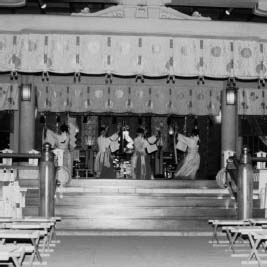ShintoLeadership, Authority, and Religious Roles |
What are some of the main varieties of Shinto officials or ritual specialists? |
Shinto tradition refers to the priesthood in general as either shinshoku or kannushi. Larger shrines with full priestly staffs distinguish among a number of ranks. The chief priest is called the Guji, generally the highest ranking local official. Guji might have oversight of up to thirty subordinate shrines. The Gon-guji is second-in-command and oversees a staff of several lower ranks as well, including junior assistant chief priests (shin-gonguji). Senior priests are called negi, assistant senior priests gon-negi, and regular priests (shuten or kujo) fill out the ranks of male staff. A national ranking system also distinguishes among priests by acknowledging their levels of learning with the equivalent of academic degrees, named “purity” (jokai), “brightness” (meikai), “righteousness” (seikai), and “uprightness” (chokkai).
Young unmarried women, called shrine maidens (miko), function rather like deaconesses. Dressed in striking vermillion skirts and white blouses, they assist in blessing rituals, run the shrine shop, and perform sacred dance. Miko traditionally begin their association with the shrine and training for service as “sacred children.” Highest in rank is the unique position called saishu, found only at the Ise shrine and held by a woman. She is an imperial princess with the symbolic title “master of the matsuri (festivals).” Assisting her is a priest with the rank of dai-guji, “great chief priest,” a function unique to Ise. In the imperial household, ritual specialists have either of two ranks. The shoten parallels the shrine rank of senior priest, the shotenho that of assistant senior priest. But the emperor himself or a personal delegate presides, much as the Chinese sovereign once did, at over two dozen annual ceremonies.

Shrine deaconesses (miko) dance together on a stage at Tokyo’s downtown Hie Jinja shrine.
